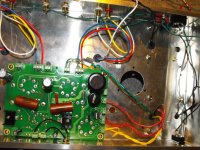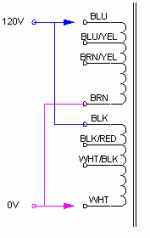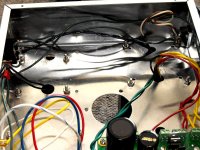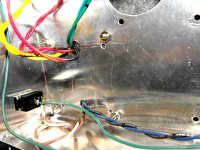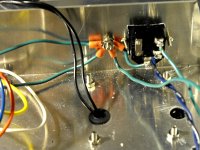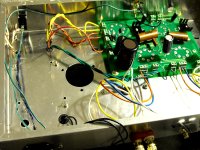The board is populated and the amp is wired up and nothing happens...
I have no idea what the problem might be.
I've wired it up so
- no choke
- no aux capacitor
- no volume control
- it is in triode mode
I've tried to make is as simple as possible for my first time start-up.
At first the fuses blew when I powered it up, but then I reversed the leads coming from the power socket and the fuses no longer blew when I turned the power on.
Not sure what to do next....
Thanks,
Glenn
I have no idea what the problem might be.
I've wired it up so
- no choke
- no aux capacitor
- no volume control
- it is in triode mode
I've tried to make is as simple as possible for my first time start-up.
At first the fuses blew when I powered it up, but then I reversed the leads coming from the power socket and the fuses no longer blew when I turned the power on.
Not sure what to do next....
Thanks,
Glenn
Hello PDL
Yes I did install R1.
No, the tubes do not glow.
I got out my magnifying glass and noticed that, although the fuse had not turned black (as the previous three had), it had blown. It seems that as soon as I turn the power on the fuse blows.
Does that mean there is a short?
Here is a photograph of my wiring.
Thanks,
Glenn
Yes I did install R1.
No, the tubes do not glow.
I got out my magnifying glass and noticed that, although the fuse had not turned black (as the previous three had), it had blown. It seems that as soon as I turn the power on the fuse blows.
Does that mean there is a short?
Here is a photograph of my wiring.
Thanks,
Glenn
Attachments
Like this? https://www.hammfg.com/files/products/300/300s-120.gif
I would start simple fault check by disconnect transformer secondary, power up and measure if you have wired correctly and have the right voltages. Use wago or something like that.
Is fuse in power socket? How large is it?
I would start simple fault check by disconnect transformer secondary, power up and measure if you have wired correctly and have the right voltages. Use wago or something like that.
Is fuse in power socket? How large is it?
Medisinmannen - yes, that is the diagram that I used to wire up my 374BX. I'll include a photograph of my wiring.
Yes my fuse is in the power socket. It's the smaller size type (~ 2 cm by 0.5 cm) 250V 1A quick acting (I think that means fast blow.)
w5jag - truthfully, I'm not sure that I've wired it up correctly. If I have wired it up correctly, this is the next thing I'll do. But I'm thinking that it's more likely that I've made some sort of rookie mistake in the transformer hookup.
Ok, so I've included an illustration of what I'm aiming for and a photograph of what I did.
Thanks,
Glenn
Yes my fuse is in the power socket. It's the smaller size type (~ 2 cm by 0.5 cm) 250V 1A quick acting (I think that means fast blow.)
w5jag - truthfully, I'm not sure that I've wired it up correctly. If I have wired it up correctly, this is the next thing I'll do. But I'm thinking that it's more likely that I've made some sort of rookie mistake in the transformer hookup.
Ok, so I've included an illustration of what I'm aiming for and a photograph of what I did.
Thanks,
Glenn
Attachments
se 845
hello I'm working on a gm70 se based on the 845. It works but I have a trouble with the 150 b+ with high current consumption 280 ma. every thing seems to be correct, as bias on 2A3 and gm70 . Obviously the power drive became hot. The first stage Ia is correct, (10 mA) as the 2A3 (30mA). I'm not able to understand why, someone could help me? Thanks
hello I'm working on a gm70 se based on the 845. It works but I have a trouble with the 150 b+ with high current consumption 280 ma. every thing seems to be correct, as bias on 2A3 and gm70 . Obviously the power drive became hot. The first stage Ia is correct, (10 mA) as the 2A3 (30mA). I'm not able to understand why, someone could help me? Thanks
You are using the TSE to drive GM70's?
I would start a new thread and maybe George (Tubelab) will see it.
I think he is the only one that has done something like that; the rest of us probably can't help you much.
Sounds neat - looking forward to seeing it and reading about it !
Win W5JAG
I would start a new thread and maybe George (Tubelab) will see it.
I think he is the only one that has done something like that; the rest of us probably can't help you much.
Sounds neat - looking forward to seeing it and reading about it !
Win W5JAG
Try starting another thread so it doesn't get confused in this one.hello I'm working on a gm70 se based on the 845. It works but I have a trouble with the 150 b+ with high current consumption 280 ma. every thing seems to be correct, as bias on 2A3 and gm70 . Obviously the power drive became hot. The first stage Ia is correct, (10 mA) as the 2A3 (30mA). I'm not able to understand why, someone could help me? Thanks
Medisinmannen
- I would start simple fault check by disconnect transformer secondary, power up and measure if you have wired correctly and have the right voltages. Use wago or something like that.
I didn't understand this at first but it seems so obvious now. So I disconnected the transformer secondary as suggested powered up and the fuse blew. I had disconnected all the secondary wires so I did it again but this time I used the red wire with the yellow strip (center tap?) to ground to the chassis. The fuse blew again.
I tried a different power socket (without a fuse) and connected it to a larger fuse (from a guitar amp, larger in physical size but still 1A 250V fast blow.) It blew as soon as I turned the amp on.
pblix
- My money is on high inrush current while C1 & C2 are charging at start-up. I would change to a slow blow fuse.
Here is what I have for C1 & C2
C1 - 33 uF
C2 - 200 uF
Does this happen every once in a while? That someone needs to use a slow blow fuse...is C2 too high?
I seem to remember George saying that C1 & C2 should be over 100 uF and that 150 uF + is better. Did I go too far by getting a 200 uF C2?
- I would start simple fault check by disconnect transformer secondary, power up and measure if you have wired correctly and have the right voltages. Use wago or something like that.
I didn't understand this at first but it seems so obvious now. So I disconnected the transformer secondary as suggested powered up and the fuse blew. I had disconnected all the secondary wires so I did it again but this time I used the red wire with the yellow strip (center tap?) to ground to the chassis. The fuse blew again.
I tried a different power socket (without a fuse) and connected it to a larger fuse (from a guitar amp, larger in physical size but still 1A 250V fast blow.) It blew as soon as I turned the amp on.
pblix
- My money is on high inrush current while C1 & C2 are charging at start-up. I would change to a slow blow fuse.
Here is what I have for C1 & C2
C1 - 33 uF
C2 - 200 uF
Does this happen every once in a while? That someone needs to use a slow blow fuse...is C2 too high?
I seem to remember George saying that C1 & C2 should be over 100 uF and that 150 uF + is better. Did I go too far by getting a 200 uF C2?
You need a slow blow fuse, it is the recommended fuse for this amp. I believe a three amp slow blow is specified for 120V operation, but I can't be certain off the top of my head.
You pictures are hard to comprehend. Please label the power inlet side and your switch. A closeup of the power inlet side would be useful.
Don't tie the center tap to ground, use the board connection.
You pictures are hard to comprehend. Please label the power inlet side and your switch. A closeup of the power inlet side would be useful.
Don't tie the center tap to ground, use the board connection.
Last edited:
Ok, I'll pick up a package of slow blow fuses. I was under the impression that I needed a fast blow fuse, but I did not get that info from George so...
I'm starting a new job tomorrow but once I get home I'll try the slow blow fuse and if it doesn't work I'll take a few more pictures to better illustrate my wiring job.
Thanks for the advice
Glenn
I'm starting a new job tomorrow but once I get home I'll try the slow blow fuse and if it doesn't work I'll take a few more pictures to better illustrate my wiring job.
Thanks for the advice
Glenn
Using slow blow fuses to remedy high inrush current at startup is a perfectly acceptable long term solution. I see no issue with the values you have selected for C1 and C2. If you want to be able to use fast acting fuses you could do so by removing R1 and adding a choke. With the values of C1 and C2, a 1H choke should work well. The Triad C-24X is a good and economical option.
George saying that C1 & C2 should be over 100 uF and that 150 uF + is better. Did I go too far by getting a 200 uF C2? .....Here is what I have for C1 & C2..C1 - 33 uF..C2 - 200 uF
Those values are fine. C1 must be 50 uF or less to make the rectifier tube happy. C2 can be quite large. My own SSE has C1 = 47 uF and C2 total = 250 uF (150 uF cap on board, 100 uF supplemental cap).
I believe a three amp slow blow is specified for 120V operation
I usually recommend a 2 amp SLOW BLOW fuse for North American 120 volt power. The early FRED diodes had a bad habit of shorting out during a thunderstorm in Florida so I tried some 1.6A slow blow fuses that I had. Those fuses would blow during a storm, and sometimes for no reason, but the diodes still died. The Fairchild diodes worked fine even during a storm, but they have become hard to get.
A 3 amp fuse might not blow if a dead short, or other high current condition like a runaway output tube existed on the high voltage supply. A European owner had a power transformer fry due to a bad output tube. He was using a 2 amp fuse on 240 volts, which is equal to a 4 amp fuse on 120 volts.
A 1 amp fast blow fuse is definitely too small for this job since the amp consumes about 1 amp once it is warmed up and operating according to my KillaWatt.
If the correct fuse blows when ALL secondary wires are disconnected from the board (taped up or otherwise not touching each other or anything), then there is something wrong with the transformer or its wiring. The wiring looks OK from what I can see in the picture. Make sure that no wires are pinched or cut where they come through the chassis.
If the fuse lives when all transformer wires are disconnected, but blows when reconnected, try the amp with no tubes at all. If it still blows, the FRED diodes may be bad. They amp will work without them. They are only needed for the solid state rectifier option.
With the values of C1 and C2, a 1H choke should work well. The Triad C-24X is a good and economical option.
George I would appreciate you chiming in on this. I am in the process of selecting a choke for my SSE parts include (EDCOR - CXSE25-5K with 8 ohm secondary, TEMCo Motor Run Capacitor RC0096, Allied 6K7VG TRANSFORMER, I am going to start with JJ EL34 tubes then switch to Electro-Harmonix KT88 tubes.I also plan on using a Feedback Switch and Triode/UL switch. No SS Rectifier.(unless you want to talk me into using a switch between it and tube rectifier).
Which Power choke should I use and why?
$62.24 Edcor CXC125- 10H-200mA DC Resistance 75 Ohm
$47.01 Edcor CXC100- 7H-150mA DC Resistance 104 Ohm
$15.33 Triad Magnetics 6H-200mA DC Resistance 150 Ohm
$37.72 Hammond 193B 12H-100mA DC Resistance 155 Ohm
$45.25 Hammond 193D 8H-150mA DC Resistance 75 Ohm
or any others you can recomend?
The speakers I am using are 98 db sensitivity Cornwalls. I like my Rock n Roll loud. Robin Trower, Pink Floyd, Black Sabbath.
Thanks

Tubelab
- If the correct fuse blows when ALL secondary wires are disconnected from the board (taped up or otherwise not touching each other or anything), then there is something wrong with the transformer or its wiring.
Thanks for the advice George, I disconnected the secondary wires from the board (with my new 3A SLOW BLOW fuse, I'll pick up some 2A fuses tomorrow) and measured the voltages ~ 5V and change, 6V and change and I think 750V. So it works with a slow blow fuse and the transformer is fine.
I connected it to the board and the fuse blew.
I'll try it again without tubes and see what happens.
I've included some pictures to help illustrate my wiring. I think my power switch is upside down but I'll fix that later.
DaMuffinMan
- Robin Trower, Pink Floyd, Black Sabbath.
Really? That's all fine but I was sort of expecting a little FZ with a name like muffin man...
- If the correct fuse blows when ALL secondary wires are disconnected from the board (taped up or otherwise not touching each other or anything), then there is something wrong with the transformer or its wiring.
Thanks for the advice George, I disconnected the secondary wires from the board (with my new 3A SLOW BLOW fuse, I'll pick up some 2A fuses tomorrow) and measured the voltages ~ 5V and change, 6V and change and I think 750V. So it works with a slow blow fuse and the transformer is fine.
I connected it to the board and the fuse blew.
I'll try it again without tubes and see what happens.
I've included some pictures to help illustrate my wiring. I think my power switch is upside down but I'll fix that later.
DaMuffinMan
- Robin Trower, Pink Floyd, Black Sabbath.
Really? That's all fine but I was sort of expecting a little FZ with a name like muffin man...
Attachments
Win W5JAG
- If you are assured you have wired the transformer, etc., correctly, I would remove both of the hexfred rectifier diodes from the printed circuit board to eliminate them as an issue. When these fail, the fuse will blow instantly.
Unless someone points out a mistake in my wiring, I'll remove the hexfred rectifier diodes tomorrow. I tried starting up the amp without the valves, as George had suggested, and the fuse blew.
Thanks for the advice,
Glenn
- If you are assured you have wired the transformer, etc., correctly, I would remove both of the hexfred rectifier diodes from the printed circuit board to eliminate them as an issue. When these fail, the fuse will blow instantly.
Unless someone points out a mistake in my wiring, I'll remove the hexfred rectifier diodes tomorrow. I tried starting up the amp without the valves, as George had suggested, and the fuse blew.
Thanks for the advice,
Glenn
- Status
- This old topic is closed. If you want to reopen this topic, contact a moderator using the "Report Post" button.
- Home
- More Vendors...
- Tubelab
- SSE - no music :(
